Everyone Can Implement Eduball in Physical Education to Develop Cognitive and Motor Skills in Primary School Students
Abstract
1. Introduction
2. Materials and Methods
2.1. Participants
2.2. Experimental Factor
2.3. Procedure
2.3.1. Test of Gross Motor Development—Second Edition (TGMD-2)
2.3.2. Test of Skills at School Start (TUNSS)
2.4. Data Analysis
3. Results
4. Discussion
4.1. Eduball and Motor Skills
4.2. Eduball and Cognitive Skills
4.3. Eduball and Teacher Types
5. Conclusions
Author Contributions
Funding
Institutional Review Board Statement
Informed Consent Statement
Data Availability Statement
Conflicts of Interest
References
- Deneve, S.; Pouget, A. Bayesian multisensory integration and cross-modal spatial links. J. Physiol. Paris 2004, 98, 249–258. [Google Scholar] [CrossRef] [PubMed]
- Spence, C. Crossmodal correspondences: A tutorial review. Atten. Percept. Psychophys. 2011, 73, 971–995. [Google Scholar] [CrossRef] [PubMed]
- Blanke, O. Multisensory brain mechanisms of bodily self-consciousness. Nat. Rev. Neurosci. 2012, 13, 556–571. [Google Scholar] [CrossRef]
- Hoffmann, S.; Borges, U.; Broker, L.; Laborde, S.; Liepelt, R.; Lobinger, B.H.; Loffler, J.; Musculus, L.; Raab, M. The psychophysiology of action: A multidisciplinary endeavor for integrating action and cognition. Front. Psychol. 2018, 9, 1423. [Google Scholar] [CrossRef] [PubMed]
- Przybylski, L.; Kroliczak, G. Planning functional grasps of simple tools invokes the hand-independent praxis representation network: An fMRI study. J. Int. Neuropsychol. Soc. 2017, 23, 108–120. [Google Scholar] [CrossRef]
- Donnelly, J.E.; Hillman, C.H.; Castelli, D.; Etnier, J.L.; Lee, S.; Tomporowski, P.; Lambourne, K.; Szabo-Reed, A.N. Physical activity, fitness, cognitive function, and academic achievement in children: A systematic review. Med. Sci. Sports Exerc. 2016, 48, 1197–1222. [Google Scholar] [CrossRef]
- Norris, E.; van Steen, T.; Direito, A.; Stamatakis, E. Physically active lessons in schools and their impact on physical activity, educational, health and cognition outcomes: A systematic review and meta-analysis. Br. J. Sports Med. 2020, 54, 826–838. [Google Scholar] [CrossRef]
- Marttinen, R.H.J.; McLoughlin, G.; Fredrick, R.; Novak, D. Integration and physical education: A review of research. Quest 2016, 69, 37–49. [Google Scholar] [CrossRef]
- Sember, V.; Jurak, G.; Kovac, M.; Morrison, S.A.; Starc, G. Children’s physical activity, academic performance, and cognitive functioning: A systematic review and meta-analysis. Front. Public Health 2020, 8, 307. [Google Scholar] [CrossRef]
- Watson, A.; Timperio, A.; Brown, H.; Best, K.; Hesketh, K.D. Effect of classroom-based physical activity interventions on academic and physical activity outcomes: A systematic review and meta-analysis. Int. J. Behav. Nutr. Phys. Act. 2017, 14, 114. [Google Scholar] [CrossRef]
- Zach, S.; Shoval, E.; Lidor, R. Physical education and academic achievement—Literature review 1997–2015. J. Curric. Stud. 2017, 49, 703–721. [Google Scholar] [CrossRef]
- World Health Organization. Global Action Plan on Physical Activity 2018–2030: More Active People for a Healthier World; World Health Organization: Geneva, Switzerland, 2018. [Google Scholar]
- Rokita, A.; Cichy, I.; Wawrzyniak, S.; Korbecki, M. Eduball Games and Sports; AWF: Wroclaw, Poland, 2017. [Google Scholar]
- Rokita, A.; Wawrzyniak, S.; Cichy, I. Learning by Playing! 100 Games and Exercises of Brainballs; AWF: Wroclaw, Poland, 2018. [Google Scholar]
- Cichy, I.; Kaczmarczyk, M.; Wawrzyniak, S.; Kruszwicka, A.; Przybyla, T.; Klichowski, M.; Rokita, A. Participating in physical classes using Eduball stimulates acquisition of mathematical knowledge and skills by primary school students. Front. Psychol. 2020, 11, 2194. [Google Scholar] [CrossRef] [PubMed]
- Wawrzyniak, S.; Cichy, I.; Matias, A.R.; Pawlik, D.; Kruszwicka, A.; Klichowski, M.; Rokita, A. Physical activity with Eduball stimulates graphomotor skills in primary school students. Front. Psychol. 2021, 12, 614138. [Google Scholar] [CrossRef] [PubMed]
- Pham, V.H.; Wawrzyniak, S.; Cichy, I.; Bronikowski, M.; Rokita, A. BRAINballs program improves the gross motor skills of primary school pupils in Vietnam. Int. J. Environ. Res. Public Health 2021, 18, 1290. [Google Scholar] [CrossRef] [PubMed]
- Cichy, I.; Kruszwicka, A.; Krysman, A.; Przybyla, T.; Rochatka, W.; Szala, E.; Wawrzyniak, S.; Bronikowski, M.; Klichowski, M.; Rokita, A. Eduball as a method of brain training for lower performing students with dyslexia: A one-year experiment in natural settings. Int. J. Disabil. Hum. Dev. 2022, in press. [Google Scholar]
- Cichy, I.; Rokita, A. The use of the “Eduball” educational ball in rural and urban primary schools and the physical fitness levels of children. Hum. Mov. 2012, 13, 247–257. [Google Scholar] [CrossRef]
- European Commission/EACEA/Eurydice. Physical Education and Sport at School in Europe, Eurydice Report; Publications Office of the European Union: Luxembourg, 2013; Available online: https://eacea.ec.europa.eu/national-policies/eurydice/content/physical-education-and-sport-school-europe_en (accessed on 26 November 2021).
- Griggs, G.; Fleet, M. Most people hate physical education and most drop out of physical activity: In search of credible curriculum alternatives. Educ. Sci. 2021, 11, 701. [Google Scholar] [CrossRef]
- Coulter, M.; Marron, S.; Murphy, M.; Cosgrave, C.; Sweeney, T.; Dawson, G. Teaching PE: The central role of the class teacher. Intouch 2009, 102, 39–41. [Google Scholar]
- Fletcher, T.; Mandigo, J. The primary schoolteacher and physical education: A review of research and implications for Irish physical education. Ir. Educ. Stud. 2012, 31, 363–376. [Google Scholar] [CrossRef]
- Fletcher, T.; Mandigo, J.; Kosnik, C. Elementary classroom teachers and physical education: Change in teacher-related factors during pre-service teacher education. Phys. Educ. Sport Pedagogy 2012, 18, 169–183. [Google Scholar] [CrossRef]
- Morgan, P.; Hansen, V. Physical education in primary schools: Classroom teachers’ perceptions of benefits and outcomes. Health Educ. J. 2008, 67, 196–207. [Google Scholar] [CrossRef]
- Morgan, P.; Hansen, V. Classroom teachers’ perceptions of the impact of barriers to teaching physical education on the quality of physical education programs. Res. Q. Exerc. Sport 2008, 79, 506–516. [Google Scholar] [CrossRef]
- Decorby, K.; Halas, J.; Dixon, S.; Wintrup, L.; Janzen, H. Classroom teachers and the challenges of delivering quality physical education. J. Educ. Res. 2005, 98, 208–221. [Google Scholar] [CrossRef]
- Telford, R.D.; Cunningham, R.B.; Fitzgerald, R.; Olive, L.S.; Prosser, L.; Jiang, X.; Telford, R.M. Physical education, obesity, and academic achievement: A 2-year longitudinal investigation of Australian elementary school children. Am. J. Public Health 2012, 102, 368–374. [Google Scholar] [CrossRef] [PubMed]
- Telford, R.D.; Cunningham, R.; Abhayaratna, W.; Telford, R.; Olive, L. Physical activity, physical education and academic performance. J. Sci. Med. Sport 2014, 18, e65–e66. [Google Scholar] [CrossRef]
- McGhie, S.; Dyar, M.L.; Simmons, R. United we stand: Physical educators and classroom teachers should work together. Strategies 1994, 7, 12–16. [Google Scholar] [CrossRef]
- Lynch, T. How does a physical education teacher become a health and physical education teacher? Sport Educ. Soc. 2017, 22, 355–376. [Google Scholar] [CrossRef]
- Russ, L. The role of physical educators in helping classroom teachers to promote physical activity. J. Phys. Educ. Recreat. Dance 2015, 86, 18–24. [Google Scholar] [CrossRef]
- Lorek, M.; Wolman, L. Our Elementary: Autumn (Part 1), Winter (Part 2), Textbook for Elementary School; Ministry of National Education: Warszawa, Poland, 2014.
- Lorek, M.; Ochmańska, B.; Wollman, L. Our Elementary: Spring (Part 3), Summer (Part 4) Textbook for Elementary School; Ministry of National Education: Warszawa, Poland, 2014.
- Ulrich, D.A. Test of Gross Motor Development, 2nd ed.; PRO-ED: Austin, TX, USA, 2000. [Google Scholar]
- Kaczan, R.; Rycielski, P. Diagnoza Umiejetnosci Dzieci 5-, 6- i 7-Letnich za Pomoca Testu Umiejetnosci na Starcie Szkolnym TUnSS. In Proceedings of the XVIII Konferencja Diagnostyki Edukacyjnej 2012, Wroclaw, Poland, 22–23 September 2012. [Google Scholar]
- Bisi, M.C.; Panebianco, G.P.; Polman, R.; Stagni, R. Objective assessment of movement competence in children using wearable sensors: An instrumented version of the TGMD-2 locomotor subtest. Gait Posture 2017, 56, 42–48. [Google Scholar] [CrossRef]
- Sawilowsky, S. New effect size rules of thumb. J. Mod. Appl. Stat. Methods 2009, 8, 467–474. [Google Scholar] [CrossRef]
- Cichy, I.; Rokita, A.; Wolny, M.; Popowczak, M. Effect of physical exercise games and playing with Edubal educational balls on eye-hand coordination in first-year primary school children. Med. Dello Sport 2015, 68, 461–472. [Google Scholar]
- Cecchini, J.; Carriedo, A. Effects of an interdisciplinary approach integrating mathematics and physical education on mathematical learning and physical activity levels. J. Teach. Phys. Educ. 2020, 39, 121–125. [Google Scholar] [CrossRef]
- Morgan, P.J.; Barnett, L.M.; Cliff, D.P.; Okely, A.D.; Scott, H.A.; Cohen, K.E.; Lubans, D.R. Fundamental movement skill interventions in youth: A systematic review and meta-analysis. Pediatrics 2013, 132, e1361–e1383. [Google Scholar] [CrossRef]
- Engel, A.C.; Broderick, C.R.; van Doorn, N.; Hardy, L.L.; Parmenter, B.J. Exploring the relationship between fundamental motor skill interventions and physical activity levels in children: A systematic review and meta-analysis. Sports Med. 2018, 48, 1845–1857. [Google Scholar] [CrossRef]
- Herbst, M.; Strawinski, P. Early effects of an early start: Evidence from lowering the school starting age in Poland. J. Policy Model. 2016, 38, 256–271. [Google Scholar] [CrossRef][Green Version]
- Korbecki, M.; Wawrzyniak, S.; Rokita, A. Fundamental movement skills of six- to seven-year-old children in the first grade of elementary school: A pilot study. Balt. J. Health Phys. Act. 2017, 9, 22–31. [Google Scholar] [CrossRef]
- Panskyi, T.; Korzeniewska, E. Bridging the informatics gap between school and university with the InfoSukces contest. Inform. Educ. 2021, 20, 436–488. [Google Scholar] [CrossRef]
- Griffo, J.M.; Hodges-Kulinna, P.; Marttinen, R.H.J.; Battistella, S. A systematic review of integrative practices in physical education (2009–2018). Int. J. Educ. Res. 2020, 104, 101689. [Google Scholar] [CrossRef]
- Klichowski, M.; Kroliczak, G. Numbers and functional lateralization: A visual half-field and dichotic listening study in proficient bilinguals. Neuropsychologia 2017, 100, 93–109. [Google Scholar] [CrossRef]
- Kroliczak, G.; Buchwald, M.; Kleka, P.; Klichowski, M.; Potok, W.; Nowik, A.M.; Randerath, J.; Piper, B.J. Manual praxis and language-production networks, and their links to handedness. Cortex 2021, 140, 110–127. [Google Scholar] [CrossRef]
- Kroliczak, G.; Piper, B.J.; Potok, W.; Buchwald, M.; Kleka, P.; Przybylski, L.; Styrkowiec, P.P. Praxis and language organization in left-handers. Acta Neuropsychol. 2020, 18, 15–28. [Google Scholar] [CrossRef]
- Rugani, R.; Betti, S.; Ceccarini, F.; Sartori, L. Act on numbers: Numerical magnitude influences selection and kinematics of finger movement. Front. Psychol. 2017, 8, 1481. [Google Scholar] [CrossRef] [PubMed]
- Rohlfing, K.J. Learning language from the use of gestures. In International Handbook of Language Acquisition; Horst, J.S., von Koss Torkildsen, J., Eds.; Routledge: Abingdon, VA, USA, 2019; pp. 213–233. [Google Scholar] [CrossRef]
- Philip, B.A.; Frey, S.H. Increased functional connectivity between cortical hand areas and praxis network associated with training-related improvements in non-dominant hand precision drawing. Neuropsychologia 2016, 87, 157–168. [Google Scholar] [CrossRef]
- Gonzalez, S.L.; Alvarez, V.; Nelson, E.L. Do gross and fine motor skills differentially contribute to language outcomes? A systematic review. Front. Psychol. 2019, 10, 2670. [Google Scholar] [CrossRef]
- Gracia-Bafalluy, M.; Noel, M.P. Does finger training increase young children’s numerical performance? Cortex 2008, 44, 368–375. [Google Scholar] [CrossRef] [PubMed]
- Valla, L.; Slinning, K.; Kalleson, R.; Wentzel-Larsen, T.; Riiser, K. Motor skills and later communication development in early childhood: Results from a population-based study. Child. Care Health Dev. 2020, 46, 407–413. [Google Scholar] [CrossRef]
- Vicario, C.M.; Nitsche, M.A. Transcranial direct current stimulation: A remediation tool for the treatment of childhood congenital dyslexia? Front. Hum. Neurosci. 2013, 7, 139. [Google Scholar] [CrossRef]
- Domahs, F.; Moeller, K.; Huber, S.; Willmes, K.; Nuerk, H.C. Embodied numerosity: Implicit hand-based representations influence symbolic number processing across cultures. Cognition 2010, 116, 251–266. [Google Scholar] [CrossRef]
- Fischer, M.H.; Zwaan, R.A. Embodied language: A review of the role of the motor system in language comprehension. Q. J. Exp. Psychol. 2008, 61, 825–850. [Google Scholar] [CrossRef]
- Gabric, P.; Banda, M.; Karavanic, I. Cognitive Performance and Specific Aspects of Language Processing Are Associated with Oldowan-like Chert Flaking and Retouch. 2021. Available online: https://assets.researchsquare.com/files/rs-1212115/v1/44340136-4922-4b04-ad01-a4ad86bb5ca6.pdf?c=1640880616 (accessed on 20 December 2021).
- Battaglia, G.; Alesi, M.; Tabacchi, G.; Palma, A.; Bellafiore, M. The development of motor and pre-literacy skills by a physical education program in preschool children: A non-randomized pilot trial. Front. Psychol. 2019, 9, 2694. [Google Scholar] [CrossRef]
- Aktop, A.; Karahan, N. Physical education teacher’s views of effective teaching methods in physical education. Procedia Soc. Behav. Sci. 2012, 46, 1910–1913. [Google Scholar] [CrossRef][Green Version]
- Morbo, E.A. Instructional materials and alternative teaching practices in physical education. Indones. J. Sci. Technol. 2021, 1, 67–70. [Google Scholar] [CrossRef]
- Goh, T.L.; Hannon, J.C.; Newton, M.; Webster, C.; Podlog, L.; Pillow, W. “I’ll squeeze it in”: Transforming preservice classroom teachers’ perceptions toward movement integration in schools. Action Teach. Educ. 2013, 35, 286–300. [Google Scholar] [CrossRef]
- Hall, T.J.; Little, S.; Heidorn, B.D. Preparing classroom teachers to meet students’ physical activity needs. J. Phys. Educ. Recreat. Dance 2011, 82, 40–52. [Google Scholar] [CrossRef]
- Webster, C.A.; Caputi, P.; Perreault, M.; Doan, R.; Doutis, P.; Weaver, R.G. Elementary classroom teachers’ adoption of physical activity promotion in the context of a statewide policy: An innovation diffusion and socio-ecologic perspective. J. Teach. Phys. Educ. 2013, 32, 419–440. [Google Scholar] [CrossRef]
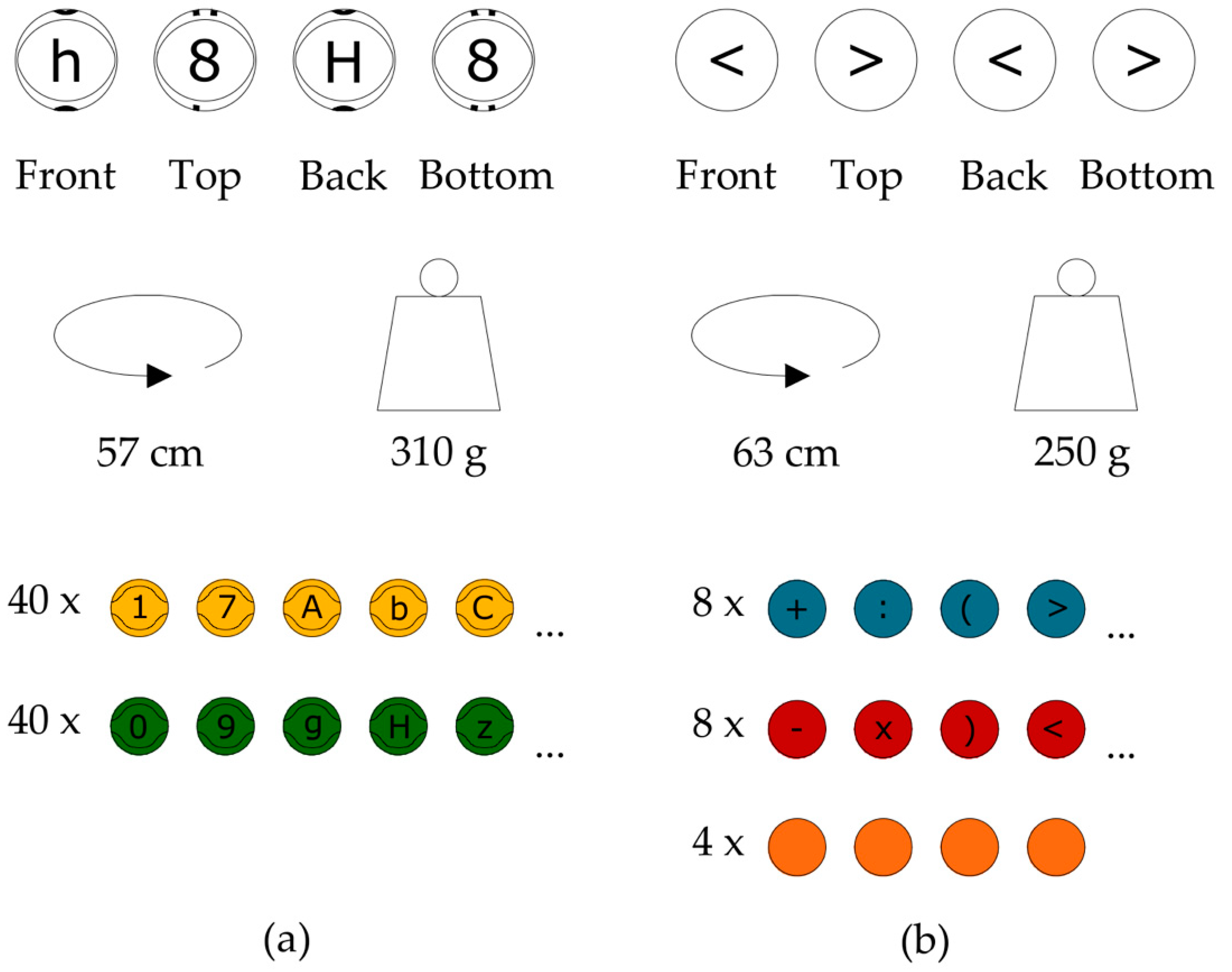
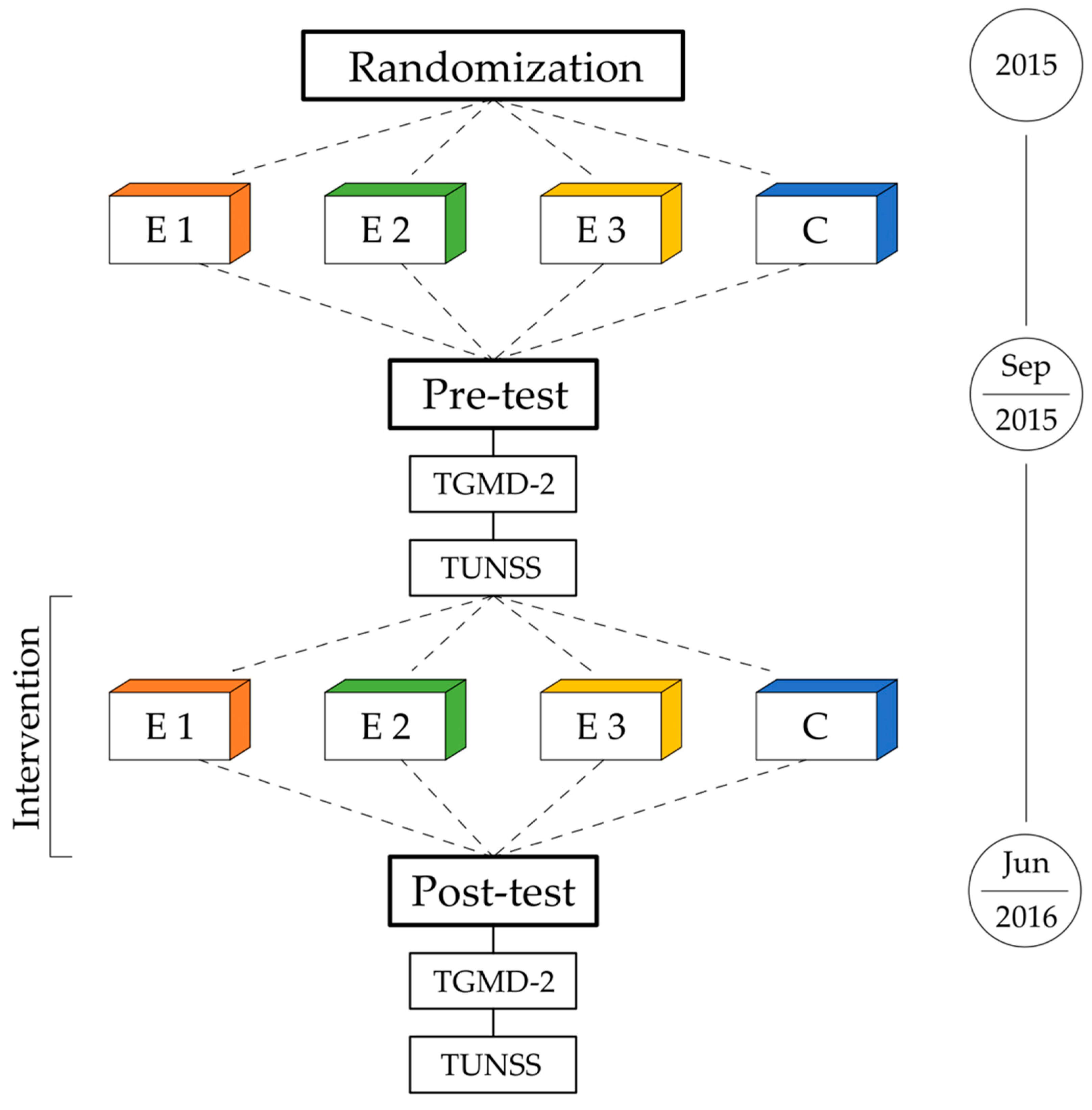
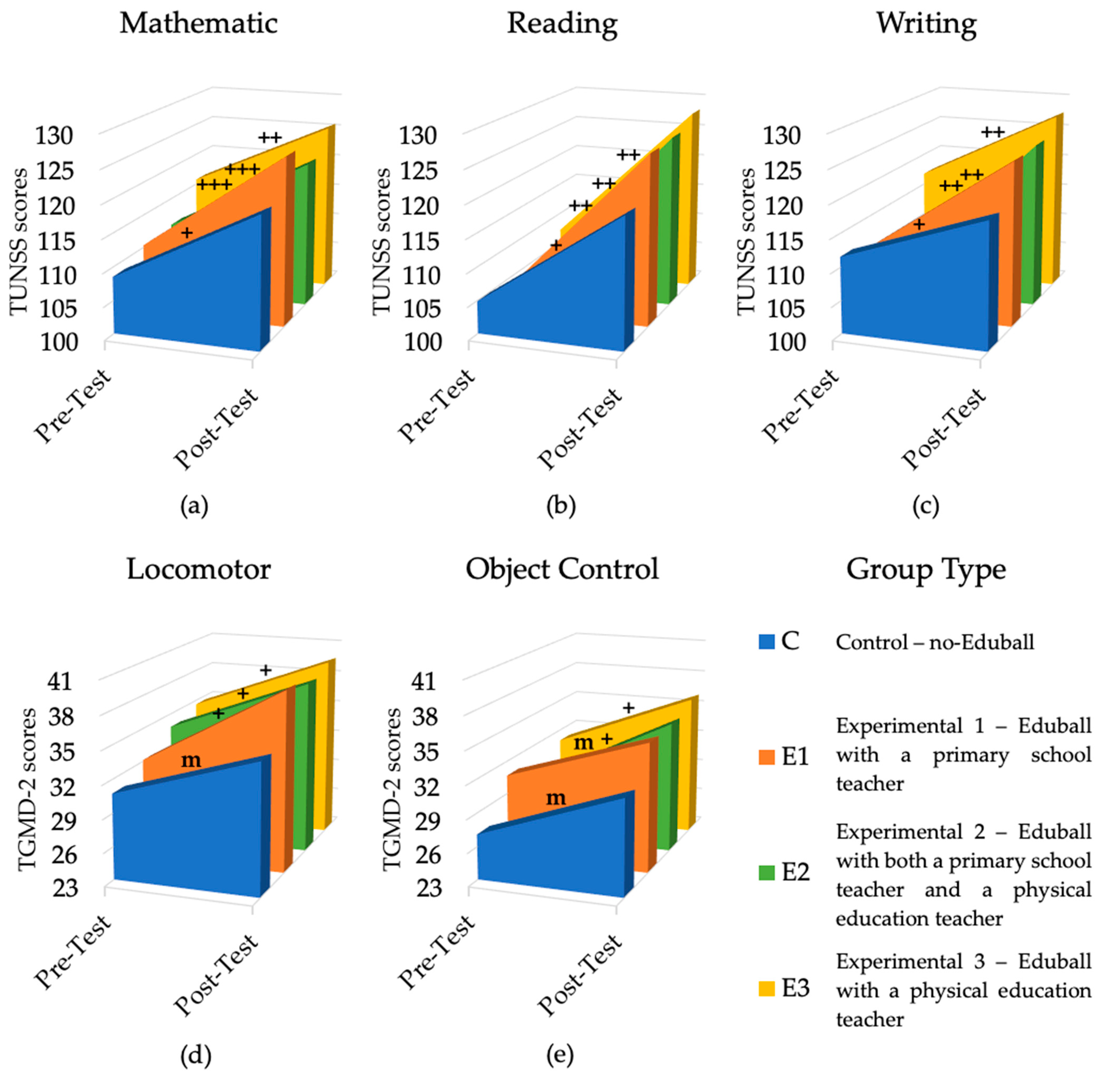
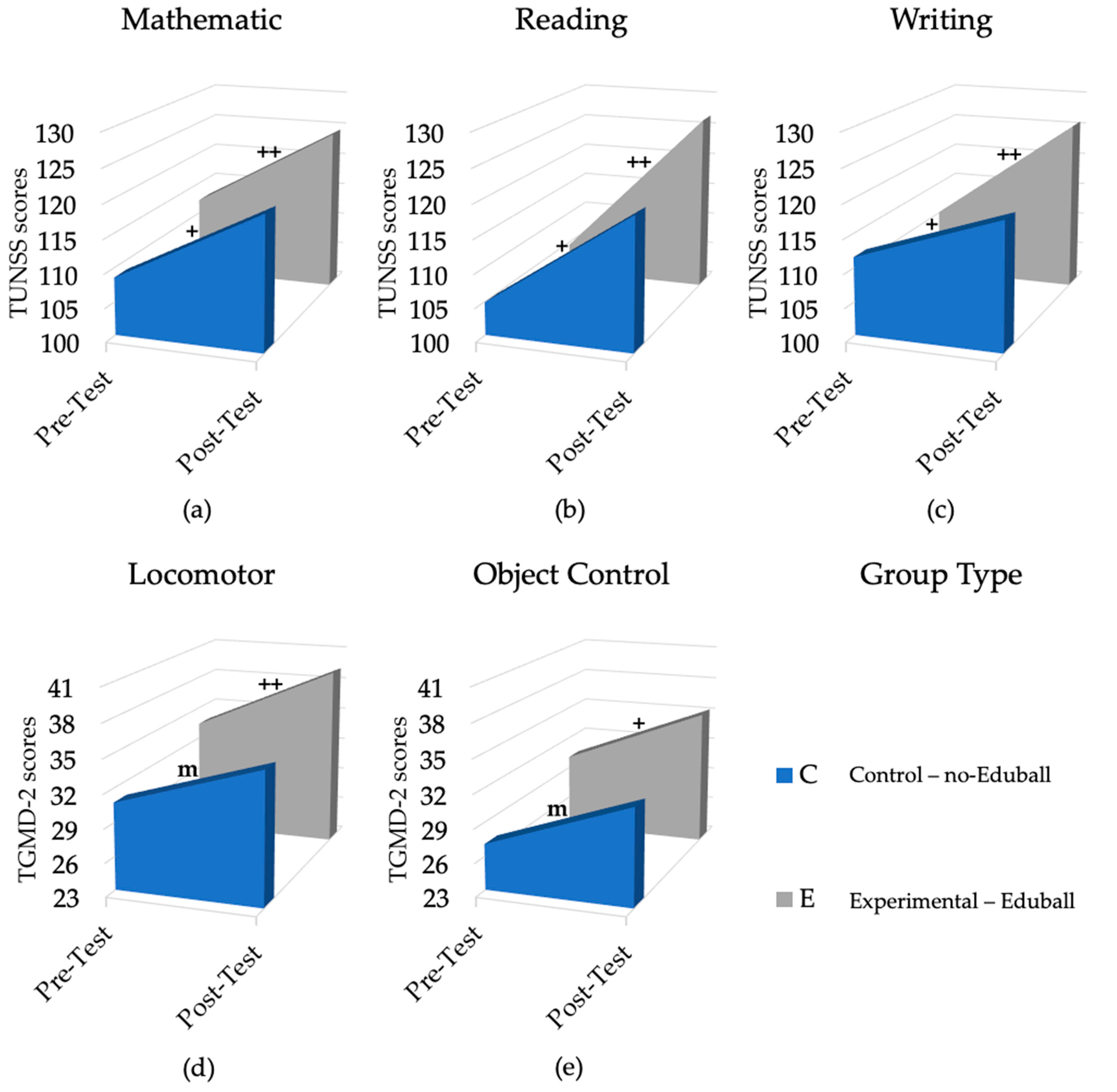

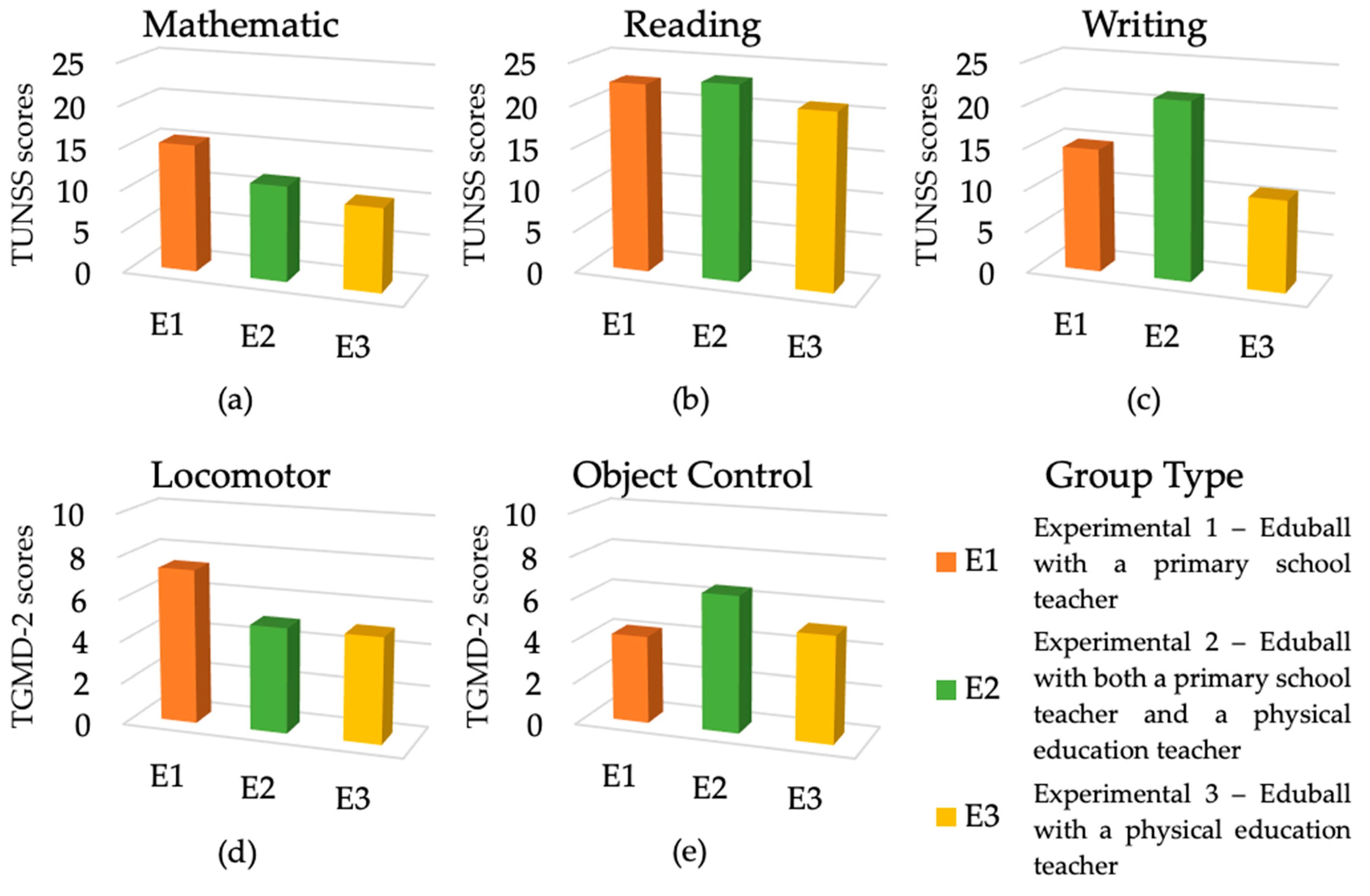
| Skills | Control Group | Experimental Group 1 | ||||||||
|---|---|---|---|---|---|---|---|---|---|---|
| Pre-Test | Post-Test | t | p | d | Pre-Test | Post-Test | t | p | d | |
| Mathematic | 108.57 ± 12.16 | 119.86 ± 10.23 | −4.71 | <0.001 | −1.03 | 110.33 ± 7.48 | 125.61 ± 6.4 | −10.62 | <0.001 | −2.50 |
| Reading | 104.9 ± 12.89 | 119.71 ± 10.5 | −5.01 | <0.001 | −1.09 | 103.61 ± 19.43 | 126.06 ± 8.94 | −5.65 | <0.001 | −1.33 |
| Writing | 111.57 ± 9.45 | 119 ± 7.15 | −3.80 | <0.01 | −0.83 | 110.17 ± 10.69 | 124.94 ± 9.17 | −5.96 | <0.001 | −1.41 |
| Locomotor | 30.76 ± 5.89 | 34.81 ± 4.98 | −2.84 | 0.01 | −0.62 | 32.11 ± 5.94 | 39.44 ± 4.87 | −4.98 | <0.001 | −1.17 |
| Run | 5.33 ± 1.98 | 6.52 ± 1.97 | −1.88 | 0.08 | −0.41 | 6.17 ± 1.58 | 6.83 ± 1.34 | −1.41 | 0.18 | −0.33 |
| Gallop | 5.29 ± 1.19 | 5.1 ± 1.95 | 0.41 | 0.69 | 0.09 | 5.94 ± 1.16 | 6 ± 1.97 | −0.11 | 0.91 | −0.03 |
| Hop | 6.05 ± 2.25 | 6.29 ± 1.76 | −0.40 | 0.69 | −0.09 | 5.44 ± 2.15 | 7.72 ± 1.81 | −3.67 | <0.01 | −0.87 |
| Leap | 4.14 ± 1.35 | 4.67 ± 1.46 | −1.21 | 0.24 | −0.26 | 4.33 ± 1.37 | 4.67 ± 1.24 | −0.79 | 0.44 | −0.19 |
| Jump | 4.62 ± 2.01 | 6.1 ± 1.64 | −2.75 | 0.01 | −0.60 | 4.94 ± 2.04 | 6.78 ± 1.31 | −4.51 | <0.001 | −1.06 |
| Slide | 5.33 ± 1.24 | 6.05 ± 1.88 | −1.61 | 0.12 | −0.35 | 5.28 ± 1.45 | 7.44 ± 0.78 | −5.44 | <0.001 | −1.28 |
| Object Control | 27.1 ± 5.55 | 31.71 ± 6.42 | −3.21 | <0.01 | −0.70 | 30.67 ± 6.26 | 34.83 ± 6 | −3.15 | 0.01 | −0.74 |
| Strike | 5.05 ± 2.2 | 6.29 ± 2.74 | −1.71 | 0.10 | −0.37 | 6.67 ± 2.38 | 5.78 ± 2.6 | 1.53 | 0.15 | 0.36 |
| Dribble | 3.1 ± 2.14 | 4.43 ± 2.09 | −2.51 | 0.02 | −0.55 | 3.5 ± 2.41 | 5.56 ± 1.82 | −3.12 | 0.01 | −0.74 |
| Catch | 4.62 ± 1.36 | 4.76 ± 1.18 | −0.53 | 0.60 | −0.12 | 4.17 ± 1.58 | 5.5 ± 0.79 | −3.69 | <0.01 | −0.87 |
| Kick | 5.71 ± 1.55 | 6.05 ± 1.66 | −0.94 | 0.36 | −0.21 | 6.44 ± 1.38 | 6.67 ± 1.97 | −0.51 | 0.61 | −0.12 |
| Throw | 3.86 ± 1.8 | 4.81 ± 1.75 | −2.12 | <0.05 | −0.46 | 4.5 ± 2.07 | 4.83 ± 2.01 | −0.74 | 0.47 | −0.17 |
| Roll | 4.71 ± 1.85 | 5.05 ± 1.94 | −0.67 | 0.51 | −0.15 | 5.72 ± 1.6 | 5.89 ± 1.45 | −0.44 | 0.67 | −0.10 |
| Skills | Experimental Group 2 | Experimental Group 3 | ||||||||
| Pre-Test | Post-Test | t | p | d | Pre-Test | Post-Test | t | p | d | |
| Mathematic | 110.75 ± 5.97 | 122.19 ± 6.27 | −8.34 | <0.001 | −2.08 | 115.73 ± 8.05 | 125.73 ± 5.65 | −5.93 | <0.001 | −1.53 |
| Reading | 103.13 ± 13.59 | 126.31 ± 9.14 | −6.38 | <0.001 | −1.60 | 107.13 ± 15.14 | 128.07 ± 7.31 | −5.73 | <0.001 | −1.48 |
| Writing | 103.81 ± 11.28 | 125.13 ± 11.71 | −5.85 | <0.001 | −1.46 | 116.73 ± 7.51 | 127.6 ± 7.06 | −4.69 | <0.001 | −1.21 |
| Locomotor | 33.75 ± 5.95 | 38.75 ± 3.99 | −3.29 | 0.01 | −0.82 | 34.6 ± 5.99 | 39.6 ± 4.4 | −3.94 | <0.01 | −1.02 |
| Run | 6.06 ± 1.48 | 7.06 ± 1.57 | −1.67 | 0.12 | −0.42 | 6.47 ± 1.81 | 7.27 ± 1.39 | −1.36 | 0.20 | −0.35 |
| Gallop | 5.38 ± 1.5 | 6 ± 1.37 | −1.11 | 0.28 | −0.28 | 5.6 ± 1.3 | 7.13 ± 1.25 | −2.62 | 0.02 | −0.68 |
| Hop | 6.63 ± 2 | 7.25 ± 1.81 | −1.25 | 0.23 | −0.31 | 7 ± 2.17 | 7.53 ± 1.96 | −1.14 | 0.27 | −0.30 |
| Leap | 4.81 ± 1.38 | 5.31 ± 0.79 | −1.23 | 0.24 | −0.31 | 4.33 ± 1.45 | 5.4 ± 0.91 | −2.87 | 0.01 | −0.74 |
| Jump | 4.94 ± 2.29 | 6.88 ± 1.59 | −3.18 | 0.01 | −0.80 | 5.8 ± 2.04 | 6.67 ± 0.98 | −1.55 | 0.14 | −0.40 |
| Slide | 5.81 ± 1.28 | 6.13 ± 1.09 | −0.69 | 0.50 | −0.17 | 5.4 ± 1.5 | 5.67 ± 1.29 | −0.70 | 0.50 | −0.18 |
| Object Control | 28.56 ± 7.75 | 35.06 ± 3.7 | −3.91 | <0.01 | −0.98 | 30.93 ± 5.48 | 36 ± 5.88 | −4.07 | <0.01 | −1.05 |
| Strike | 5.5 ± 2.22 | 6.81 ± 1.87 | −1.86 | 0.08 | −0.47 | 6 ± 1.6 | 7.2 ± 1.82 | −1.99 | 0.07 | −0.51 |
| Dribble | 3.69 ± 1.96 | 5.88 ± 1.59 | −3.35 | <0.01 | −0.84 | 4 ± 2.75 | 5.87 ± 2.1 | −4.00 | <0.01 | −1.03 |
| Catch | 4.56 ± 1.26 | 4.56 ± 1.31 | 0.00 | 1.00 | 0.00 | 5.2 ± 0.86 | 5.33 ± 0.9 | −0.52 | 0.61 | −0.13 |
| Kick | 5.06 ± 1.81 | 6.5 ± 1.71 | −2.59 | 0.02 | −0.65 | 5.93 ± 1.53 | 6.33 ± 1.68 | −0.75 | 0.47 | −0.19 |
| Throw | 5 ± 2.25 | 5.38 ± 1.93 | −0.53 | 0.61 | −0.13 | 4.87 ± 2.26 | 5.47 ± 2.17 | −1.29 | 0.22 | −0.33 |
| Roll | 4.75 ± 1.61 | 5.5 ± 1.63 | −1.34 | 0.20 | −0.34 | 4.93 ± 1.39 | 5.4 ± 1.59 | −1.10 | 0.29 | −0.28 |
| Skills | SS | SM | F | p | ηp2 | OP |
|---|---|---|---|---|---|---|
| Mathematic | 129.91 | 129.91 | 3.18 | 0.08 | 0.05 | 0.42 |
| Reading | 745.75 | 745.75 | 10.33 | <0.01 | 0.13 | 0.89 |
| Writing | 764.97 | 764.97 | 10.98 | <0.01 | 0.14 | 0.90 |
| Locomotor | 195.10 | 195.10 | 10.62 | <0.01 | 0.14 | 0.89 |
| Run | 4.45 | 4.45 | 1.73 | 0.19 | 0.03 | 0.25 |
| Gallop | 23.80 | 23.80 | 7.81 | <0.01 | 0.10 | 0.79 |
| Hop | 19.95 | 19.95 | 6.48 | 0.01 | 0.09 | 0.71 |
| Leap | 2.47 | 2.47 | 1.75 | 0.19 | 0.03 | 0.26 |
| Jump | 4.99 | 4.99 | 2.64 | 0.11 | 0.04 | 0.36 |
| Slide | 2.42 | 2.42 | 1.08 | 0.30 | 0.02 | 0.18 |
| Object Control | 70.01 | 70.01 | 2.91 | 0.09 | 0.04 | 0.39 |
| Strike | 0.05 | 0.05 | 0.01 | 0.92 | 0.00 | 0.05 |
| Dribble | 19.24 | 19.24 | 5.96 | 0.02 | 0.08 | 0.67 |
| Catch | 2.15 | 2.15 | 1.87 | 0.18 | 0.03 | 0.27 |
| Kick | 2.58 | 2.58 | 0.95 | 0.33 | 0.01 | 0.16 |
| Throw | 0.01 | 0.01 | 0.00 | 0.95 | 0.00 | 0.05 |
| Roll | 2.70 | 2.70 | 1.05 | 0.31 | 0.02 | 0.17 |
| Skills | SS | SM | F | p | ηp2 | OP |
|---|---|---|---|---|---|---|
| Mathematic | 119.40 | 59.70 | 2.42 | 0.10 | 0.10 | 0.46 |
| Reading | 14.41 | 7.20 | 0.11 | 0.89 | 0.01 | 0.07 |
| Writing | 31.13 | 15.57 | 0.18 | 0.83 | 0.01 | 0.08 |
| Locomotor | 11.86 | 5.93 | 0.35 | 0.71 | 0.02 | 0.10 |
| Run | 1.63 | 0.81 | 0.39 | 0.68 | 0.02 | 0.11 |
| Gallop | 13.13 | 6.56 | 2.62 | 0.08 | 0.10 | 0.49 |
| Hop | 6.85 | 3.42 | 1.14 | 0.33 | 0.05 | 0.24 |
| Leap | 5.20 | 2.60 | 2.51 | 0.09 | 0.10 | 0.48 |
| Jump | 1.17 | 0.58 | 0.37 | 0.70 | 0.02 | 0.11 |
| Slide | 29.16 | 14.58 | 12.87 | <0.001 | 0.36 | 1.00 |
| Object Control | 14.00 | 7.00 | 0.35 | 0.71 | 0.02 | 0.10 |
| Strike | 24.81 | 12.40 | 2.84 | 0.07 | 0.11 | 0.53 |
| Dribble | 0.65 | 0.32 | 0.11 | 0.90 | 0.00 | 0.07 |
| Catch | 8.64 | 4.32 | 4.25 | 0.02 | 0.16 | 0.71 |
| Kick | 1.47 | 0.73 | 0.24 | 0.79 | 0.01 | 0.09 |
| Throw | 2.04 | 1.02 | 0.30 | 0.74 | 0.01 | 0.09 |
| Roll | 0.53 | 0.27 | 0.12 | 0.89 | 0.01 | 0.07 |
Publisher’s Note: MDPI stays neutral with regard to jurisdictional claims in published maps and institutional affiliations. |
© 2022 by the authors. Licensee MDPI, Basel, Switzerland. This article is an open access article distributed under the terms and conditions of the Creative Commons Attribution (CC BY) license (https://creativecommons.org/licenses/by/4.0/).
Share and Cite
Wawrzyniak, S.; Korbecki, M.; Cichy, I.; Kruszwicka, A.; Przybyla, T.; Klichowski, M.; Rokita, A. Everyone Can Implement Eduball in Physical Education to Develop Cognitive and Motor Skills in Primary School Students. Int. J. Environ. Res. Public Health 2022, 19, 1275. https://doi.org/10.3390/ijerph19031275
Wawrzyniak S, Korbecki M, Cichy I, Kruszwicka A, Przybyla T, Klichowski M, Rokita A. Everyone Can Implement Eduball in Physical Education to Develop Cognitive and Motor Skills in Primary School Students. International Journal of Environmental Research and Public Health. 2022; 19(3):1275. https://doi.org/10.3390/ijerph19031275
Chicago/Turabian StyleWawrzyniak, Sara, Marcin Korbecki, Ireneusz Cichy, Agnieszka Kruszwicka, Tomasz Przybyla, Michal Klichowski, and Andrzej Rokita. 2022. "Everyone Can Implement Eduball in Physical Education to Develop Cognitive and Motor Skills in Primary School Students" International Journal of Environmental Research and Public Health 19, no. 3: 1275. https://doi.org/10.3390/ijerph19031275
APA StyleWawrzyniak, S., Korbecki, M., Cichy, I., Kruszwicka, A., Przybyla, T., Klichowski, M., & Rokita, A. (2022). Everyone Can Implement Eduball in Physical Education to Develop Cognitive and Motor Skills in Primary School Students. International Journal of Environmental Research and Public Health, 19(3), 1275. https://doi.org/10.3390/ijerph19031275









